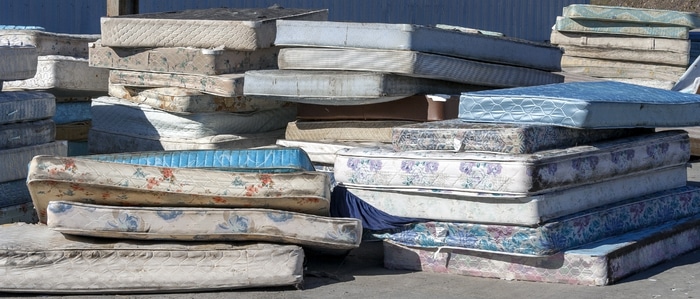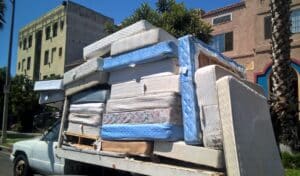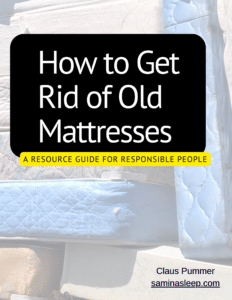Pollution is a big problem putting most landfills in crisis mode and most mattresses can take up to 120 years before they fully decompose. Memory foam mattresses are even worse taking up to 1,000 years to decompose! You want to be responsible, of course, but how do you get rid of a used mattress? And what about recycling your old mattress? What exactly are your options?
Since mattresses take up so much space in landfills, this compounds the pollution problem. That’s why sending your old, used mattress to “the dump” should be a last resort. On Earth Day (April) and National Recycling Day (November 15), we especially want to bring attention to this problem and offer some real solutions on how to recycle a mattress and other ways you can dispose of used mattresses in an environmentally responsible way.
At SAMINA, we think every day should be Earth Day. Our support of the environment underlies everything we do from selecting sustainable materials to carbon neutral production. Sadly, not everyone makes mattresses the way we do using natural, renewable, and organic materials. But we’re here to help do what we can by bringing awareness of the problem and offer some solutions.
Mattress pollution here, there, everywhere.
The Guardian said it plainly in their 2020 article, “The mattress landfill crisis: how the race to bring us better beds led to a recycling nightmare” –
“Mattresses are a global environmental nightmare.”
In the article they clearly explain how the explosion of online cheap foam mattress competition has amplified the mattress waste problem.
In the United States alone, people throw away about 20 million mattresses every year. Yet there are only 56 mattress recycling centers in the USA which is wholly insufficient. Canadians face similar challenges: one small community in Ontario estimates that 7% of the whole population sends a mattress to the landfill annually. “Everybody working in a landfill hates mattresses,” says landfill manager Aziz Rehman. No matter where you live, finding organizations that accept used mattresses are challenging to find. Not only are there hygiene and germ concerns but recycling synthetic foams and metal springs is costly and complex. There just are not that many mattress recycling options, unfortunately. That’s why we did the research to create a guide for people seeking responsible ways to get rid of a mattress.
Toxic sleep on a toxic mattress.
Nighttime is the time for your body to rest, restore, and detoxify from daily stress including exposure to toxins. But what if your own bed is the most toxic exposure of your day? Some of the biggest brands and most common mattress models are made of materials that contain volatile organic compounds, or VOC’s. These release harmful chemicals into the air as fumes and you may not even smell them.
VOC’s can be harmful to human health and even potentially cancer-causing. Yet they are not regulated so they can be found in popular substances used in many mattresses like polyurethane foams, flame retardant chemicals, and plastics. For the most part, artifical materials and chemicals used in production that end up in the final products of conventional mattresses are hazardous garbage long before you consider getting rid of them.
When you sleep in a toxic mattress, not only are you physically close to the source for maximum skin exposure, but you also breathe in their off-gassing fumes all night long. The proximity and duration of this exposure make toxic mattresses a big concern.
During the day, your exposure to chemicals is unavoidable but often limited to a short period of time or, it happens outdoors or inside of a commercial building that has more air flow and ventilation. That’s not likely the case in your bedroom. In fact, indoor air pollution has become greater than the air outside. The exposure is really a concern for children and babies. Sarah Evans, Ph.D., M.P.H., assistant professor, environmental medicine and public health, Icahn School of Medicine at Mount Sinai, New York City says –
“Often we think, well, if you let something air out for a little while, you can dramatically reduce the level of chemicals that are off-gassed…[in the mattress study] even after six months they still saw appreciable levels of off-gassing.”
As if the gaseous chemical exposure wasn’t enough, many conventional mattresses pose other health concerns. For instance:
- Skin reactions like rashes and hives
- Allergy symptoms, sneezing and snot
- Dust mite allergies
- Mold growth and symptoms of mold sensitivity
- Bed bugs and bacterial infections
F-waste and the environment.
“Known in the industry as “f-waste”, furniture waste is often overlooked by businesses and consumers because it’s generated less frequently than other types of waste. Yet furniture waste disposal is highly problematic,…it often gets dumped illegally, and eight times out of 10 simply ends up in a landfill.”
According to Canadian Mattress Recycling, a “toxic sludge builds up in the landfill’s soil” from the mattresses in landfills releasing toxic chemicals from the fire retardants and various foams. In combination with environmental exposures, “the chemicals from your bed end up in water systems, polluting the environment.” Of course, mattresses are only one example of furniture and the information presented here applies to all upholstered furniture: sofas, chairs, ottomans, and more.
After learning this, we hope you understand the importance of buying organic, biodegradable mattresses and furniture for your home. Prevention proves to be the best solution once again. It’s like smoking; it’s hard to quit so better not to start in the first place. But now you have a toxic mattress to get rid of and how do you do that? What are the mattress recycling options?
Mattress recycling options and alternatives.
You can prevent your mattress and other upholstered and stuffed furniture from ending up in landfills by donating to non-profit organizations, reputable recycling centers, or as a last resort, use a proper waste disposal service. The states of Connecticut, Rhode Island, and California all have state laws to make mattress recycling free or very low cost. Every resident in these states should take advantage of their local mattress recycling centers and services.
There really are only four options to get rid of an old, used mattress.
- Give away your mattress to friends, family, or acquaintances in need.
- Donate the mattress to a reputable non-profit organization where your bed could be put to good use.
- Recycling a mattress through an organization that will tear the mattress apart separating the component materials for repurposing.
- Last, consider responsible disposal through the community waste removal service or a professional “junk removal” company in your community.
Finding charities that accept mattress donations and mattress recycling centers can be a challenge anywhere you live. There are only around 56 mattress recycling centers in the USA is far too few for the population and almost 20 million mattresses are thrown away each year. That’s why this Earth Day, we’ve put together a resource guide, “How to Get Rid of Old Mattresses: A Resource Guide for Responsible People.” Resolve to be part of the solution, not the problem. Learn how to recycle a mattress and dispose of your old mattress responsibly. Choose a new mattress with the environment in mind. For your next bed, consider SAMINA, one of the most Earth-friendly mattress brands with an emphasis on your health as well as the Earth’s.
Get our Mattress Disposal Guide: A Resource for Responsible People
Please share this free resource with other Earthlings.
Happy Earth Day!




